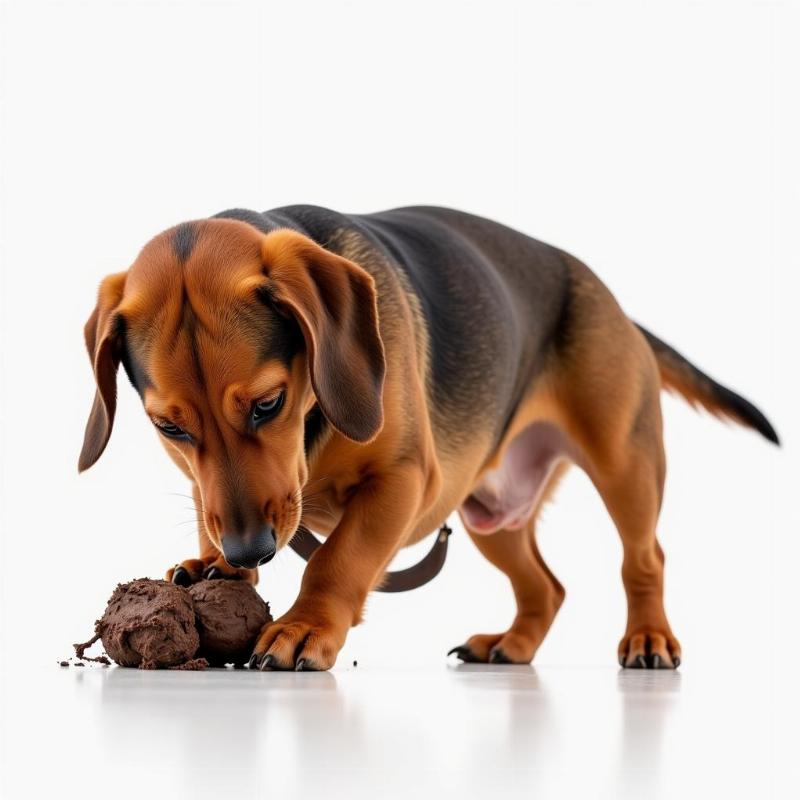Intervertebral Disc Disease (IVDD) can significantly impact a dog’s mobility and comfort, and it can also affect their ability to poop normally. If your dog has been diagnosed with IVDD, you’re likely concerned about their overall well-being, including their bathroom habits. This article will address the challenges IVDD presents for dogs trying to eliminate and offer practical advice on how to help them.
Understanding why IVDD can interfere with a dog’s ability to poop is crucial for effective management. The pain and nerve compression associated with IVDD can make it difficult for dogs to maintain the proper posture for defecation. They may struggle to squat or even lose control of their bowels. In severe cases, IVDD can lead to paralysis, further complicating the process. Knowing how to assist your dog during this challenging time can significantly improve their comfort and quality of life.
Understanding the Connection Between IVDD and Pooping Difficulties
IVDD affects the discs that cushion the vertebrae in a dog’s spine. These discs can bulge or rupture, putting pressure on the spinal cord and surrounding nerves. This pressure can cause pain, weakness, and even paralysis, making it challenging for dogs to maintain balance and control their bodily functions, including defecation. The pain associated with IVDD can make the act of squatting painful, leading to reluctance or inability to poop. Nerve damage can also disrupt the signals between the brain and the muscles involved in bowel movements.
 IVDD Dog Struggling to Poop
IVDD Dog Struggling to Poop
Practical Tips to Help Your Dog with IVDD Poop
Helping your dog with IVDD poop comfortably requires patience, understanding, and the right approach. Here are some practical tips:
- Maintain a Consistent Schedule: Establish a regular potty break routine. This predictability can help your dog anticipate and prepare for elimination.
- Provide a Comfortable and Accessible Area: Ensure the designated potty area is easy for your dog to reach and comfortable for them to use. Consider using a raised platform or providing support to help them maintain balance.
- Dietary Adjustments: Fiber-rich diets can help regulate bowel movements and soften stool, making it easier to pass. Consult your veterinarian for recommendations specific to your dog’s needs.
- Expressing the Bladder and Bowels: In some cases, manual expression may be necessary. Your veterinarian can teach you the proper technique to avoid injury.
- Medications: Your veterinarian may prescribe medications to help manage pain and inflammation, making it easier for your dog to poop.
- Physical Therapy: Targeted exercises and therapies can help improve mobility and strengthen the muscles involved in bowel movements.
When to Seek Veterinary Help
If your dog is experiencing difficulty pooping, consult your veterinarian immediately. Changes in bowel habits can indicate a worsening of IVDD or other medical issues. Don’t hesitate to seek professional advice. Early intervention is key to managing IVDD and ensuring your dog’s comfort.
Recognizing Signs of Constipation in Dogs with IVDD
Recognizing the signs of constipation is essential: straining to defecate, producing small, hard stools, or showing signs of discomfort during bowel movements. These symptoms warrant a veterinary check-up.
Conclusion
Helping a dog with IVDD poop can be challenging, but with patience and the right approach, you can significantly improve their comfort and quality of life. By understanding the connection between IVDD and pooping difficulties and implementing the tips provided, you can help your furry friend navigate this challenge. Remember, regular communication with your veterinarian is essential for managing your dog’s IVDD and ensuring their overall well-being.
FAQs
- How often should a dog with IVDD poop? Ideally, dogs should poop at least once a day. However, frequency can vary depending on diet, activity level, and individual factors.
- Can IVDD cause permanent incontinence? In some cases, severe nerve damage can lead to permanent incontinence. However, many dogs regain bowel control with proper management and therapy.
- What are the signs of a worsening IVDD? Increased pain, weakness, difficulty walking, and changes in bowel or bladder habits can indicate a worsening of IVDD.
- Is surgery always necessary for IVDD? Not all cases of IVDD require surgery. Conservative management, including medication, rest, and physical therapy, can be effective for many dogs.
- How can I make my dog more comfortable during potty breaks? Provide a soft, supportive surface, and ensure the area is easily accessible. Consider using a sling or harness to support their weight.
- Are there any specific foods to avoid for dogs with IVDD? Avoid foods high in fat and sodium, as these can contribute to inflammation. Consult your veterinarian for dietary recommendations.
- How can I prevent IVDD in my dog? Maintaining a healthy weight, providing regular exercise, and using proper lifting techniques can help reduce the risk of IVDD.
Beautdogs.us is your trusted source for comprehensive dog care information, breed insights, and product recommendations. We cater to both new and experienced dog owners, offering expert advice on all aspects of dog ownership. From understanding specific breed needs to navigating health challenges like IVDD, we provide valuable resources to help you care for your beloved companion. Contact us today for personalized support. Email: [email protected], Phone: +1 501-555-7529. Visit Beautdogs.us for more expert tips and valuable resources to ensure your dog lives a happy and healthy life.